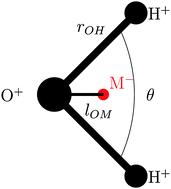A non-polarizable model of water that yields the dielectric constant and the density anomalies of the liquid: TIP4Q
Abstract
A four-site rigid

- This article is part of the themed collection: Physics and chemistry of ice and water
* Corresponding authors
a
Departamento de Química, Mexico
E-mail:
jra@xanum.uam.mx
b Departamento de Física, Universidad Autónoma Metropolitana-Iztapalapa, Av. San Rafael Atlixco 186, Col. Vicentina, 09340 México D.F., Mexico
c Instituto de Ciencias Físicas, Universidad Nacional Autónoma de México, Apartado Postal 48-3, Cuernavaca, Morelos 62251, Mexico
A four-site rigid

 Please wait while we load your content...
Something went wrong. Try again?
Please wait while we load your content...
Something went wrong. Try again?
J. Alejandre, G. A. Chapela, H. Saint-Martin and N. Mendoza, Phys. Chem. Chem. Phys., 2011, 13, 19728 DOI: 10.1039/C1CP20858F
To request permission to reproduce material from this article, please go to the Copyright Clearance Center request page.
If you are an author contributing to an RSC publication, you do not need to request permission provided correct acknowledgement is given.
If you are the author of this article, you do not need to request permission to reproduce figures and diagrams provided correct acknowledgement is given. If you want to reproduce the whole article in a third-party publication (excluding your thesis/dissertation for which permission is not required) please go to the Copyright Clearance Center request page.
Read more about how to correctly acknowledge RSC content.
 Fetching data from CrossRef.
Fetching data from CrossRef.
This may take some time to load.
Loading related content
